INTERIOR
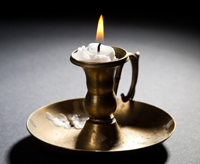 Candles
Candles
Mankind has depended on candles to light the way for over 5,000 years, going back to early Egypt and/or early Rome, depending on which authority you follow. A central core of rolled papyrus, reeds or rice paper was dipped in animal fat (tallow) or other flammable material to produce a long lasting, portable light source for home, travel, and exploration. The best fat for candle-making was sheep fat, though any animal source could be used.
In the Middle Ages, beeswax came into use as an alternative to the smelly, smoky tallow. This material was expensive, however, so beeswax candles were generally reserved for religious or ceremonial purposes.
Bayberry candles were developed in Colonial America and enjoyed great popularity for a while. However, the process of extracting wax from the bayberries was long and difficult, so like beeswax the material was impractical for daily use. Eventually spermaceti, a wax derived from sperm whale oil, became the standard material for candle making. The quality was so high that the light output from a standardized pure spermaceti candle was adopted as the standard photometric unit by English Metropolitan Gas Act of 1860.
By the end of the 19th century, candles made of paraffin (a by-product of petroleum refining) became prevalent.
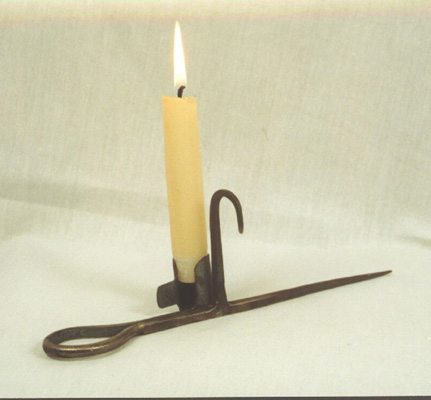 Candlesticks
Candlesticks
Candlesticks came in all shapes and sizes, but sometime in the 1860s, Comstock area miners invented a miner’s candlestick uniquely suited to their purposes. They bent the end of a spike to hold the candle; the sharp end of the spike was driven into the wall of the tunnel to hold the light.
The first such candlestick was patented in 1872 and sometime soon after a hook was added to the many emerging designs, allowing the apparatus to be hung as well as pounded in.
IMAGE: Courtesy of Shady Grove Blacksmith Shop, LLC, http://www.blksmth.com/Miners_Candle_Holder.htm
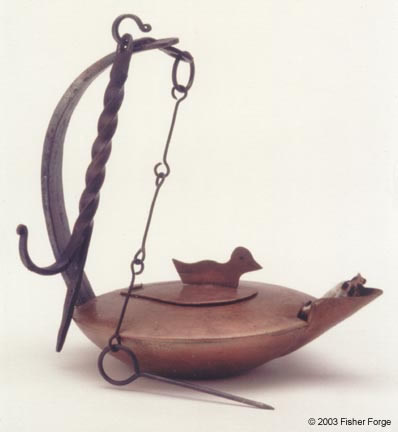 Betty Lamps
Betty Lamps
Rudimentary lamps were also in use since ancient times. These were simple, open bowls or shells with moss for a wick, filled with liquid animal fat.
In the 1600s, the Betty lamp came into use. The name derived from the German word “besser”, meaning “better”. It featured a closed spout at one end of the lamp bowl, which held the wick of cotton or other cloth securely and allowed drippings to flow back into the bowl of the lamp. The wicks had to be adjusted constantly to prevent smoking, however, and a metal pickwick to retrieve the wick from the bowl was often attached to the lamp with a chain.
A cover was also added to the Betty lamp, which confined the heat and made the lamp burn more cleanly and efficiently. The lamps themselves were made of various materials, iron at first and later, tin. Fish oil (including whale oil) was a common fuel used, though it was smelly; animal oils were also still in use until the latter part of the 19th century when petroleum products became available.
IMAGE: Courtesy of Fisher Forge, http://fisherforge.com/
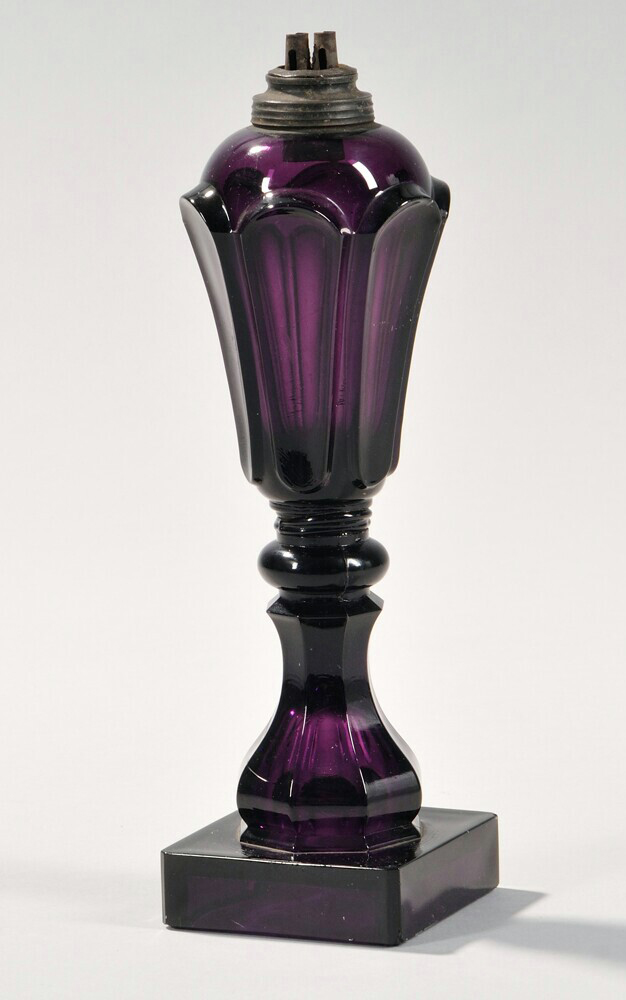 Whale Oil Lamps
Whale Oil Lamps
Whale oil was a primary fuel for lamps for nearly 150 years, beginning about 1690. New Bedford, Massachusetts became the world’s center of whaling. Over 700 whaling ships were sailing in the 1840s; of these, more than 400 hailed from New Bedford as their home port.
Initially docile baleen whales such as the bowhead whale and right whale were taken and rendered down to produce the oil, but in 1772 Nantucket fishermen captuted the first sperm whale. It was soon discovered that the sperm whale produced a far superior grade of oil called spermaceti. This oil was odorless and burned brightly, and became the standard fuel until the late 1830s.
Benjamin Franklin was a major contributor to the design of efficient whale oil lamps. He discovered that a double-wicked configuration, with the wicks separated by a wick-diameter space, increased airflow and thus produced the brightest light, also preventing sooting-up of the wicks.
Image Courtesy of Skinner, Inc., http://www.skinnerinc.com/
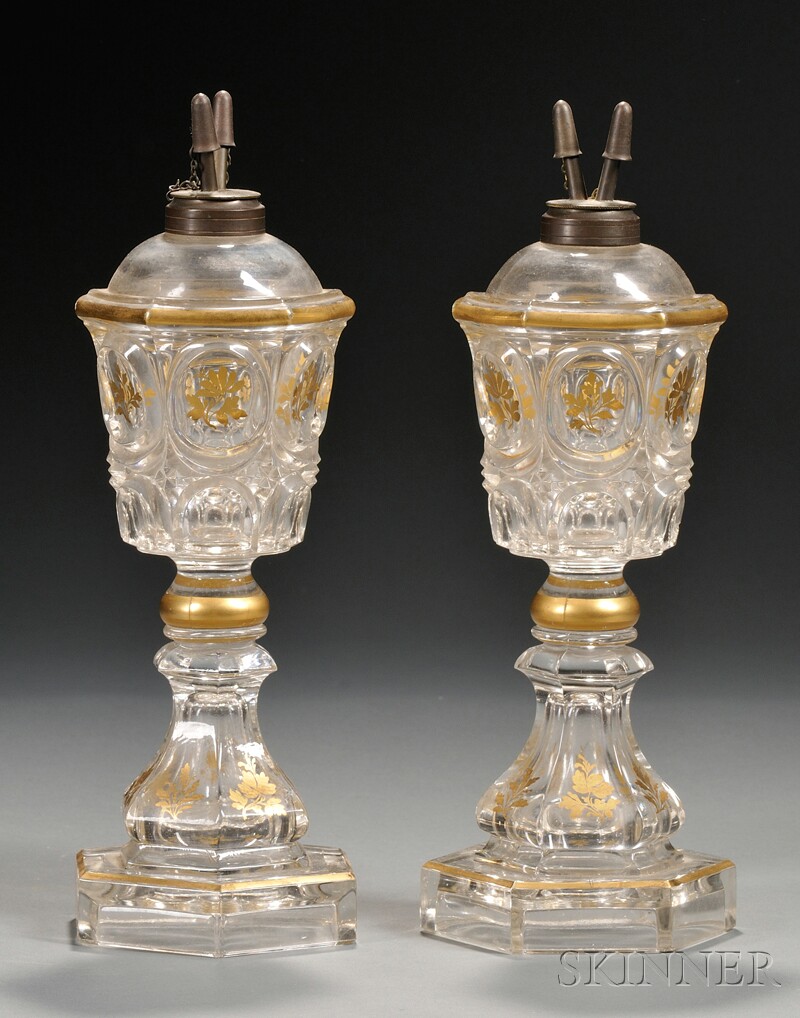 Camphene Lamps
Camphene Lamps
Camphene, also called Poter’s fluid or burning fluid, was introduced in 1837. It was a blend of alcohol, usually methanol, and turpentine, and sometimes camphor oil. It became very popular primarily because it was substantially cheaper than whale oil; in 1850 whale oil was selling for $1.30 to $2.50 per gallon, while camphene cost only 50 cents per gallon.
It had a sweet smell and gave a bright, clear light, but was unfortunately highly explosive as well. Camphene lamps have distinctive long, tapering wick tubes with thimble-like caps, which prevent the camphene from evaporating when the lamp is not in use. These tubes were angled away from each other, forming a V, primarily to dissipate the heat of the flame and avoid flash-over. The tube caps were also used as snuffers, as it was considered hazardous to try and blow the flame out.
Image Courtesy of Skinner, Inc., http://www.skinnerinc.com/
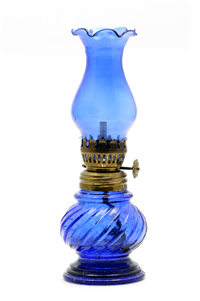 Kerosene Lamps and Lanterns
Kerosene Lamps and Lanterns
The Civil War brought an end to both the whale oil lamp and the camphene lamp, for different reasons. The Confederate ships preyed on whaling vessels from the north, bringing the taking of whales to a temporary halt, while at the same time turpentine from the southern pine forests became unavailable.
The final nail in camphene’s coffin was a heavy tax imposed on alcohol in 1862 to help finance the war; although it was intended to affect primarily drinking alcohol, it also applied to the alcohol used in camphene, making that fuel prohibitively expensive. A new lighting medium was needed, and fortunately one was waiting in the wings.
In 1846, Dr. Abraham Gesner, a Canadian geologist, had figured out a way to distill kerosene from coal, but couldn’t pursue the idea of producing it from petroleum because of opposition from coal companies of the day. Shortly thereafter, a Scottish chemist named James Young began experimenting with producing various by-products from a local coal mine, one of which he dubbed paraffine oil. Gesner and Young both took out patents on their respective processes, which were all coal-based.
In 1859, the Drake Well in western Pennsylvania was drilled, providing a cheap source of liquid petroleum. Although petroleum had been generated at other sites previously, it had been an accidental by-product of wells drilled for other purposes. Oil producers realized that kerosene could be produced from petroleum as well as coal, and that using petroleum would avoid patent fights with Gesner and Young. The switch was made, and kerosene became the lighting oil of choice in a few short years.
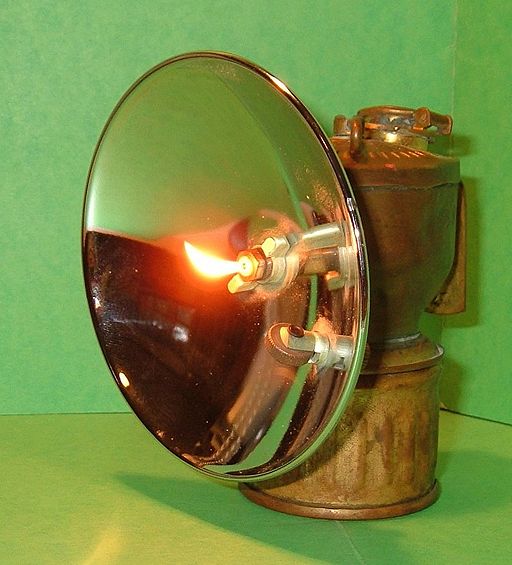 Carbide Lamps and Lanterns
Carbide Lamps and Lanterns
Carbide lamps burn acetylene which is created by the reaction of calcium carbide with water. In 1892, Thomas Willson discovered an efficient and economical process for creating calcium carbide in an electric arc furnace using a mixture of lime and coke. Since this process required large amounts of cheap electrical power, this form of lighting did not become available until after the development of an extensive electrical infrastructure.
Carbide lamps were bright light sources. They did not produce the smoke that inevitably accompanied earlier lamps, and were also lightweight and relatively safe to use. Consequently, they gained favor as miner’s lamps and are still in use today for cave exploration. They were also used for bicycle lamps and early auto headlights.
Although commercial gas and electric lighting largely supplanted lamp lighting by the time carbide lamps were invented, carbide was nonetheless used to light homes in rural areas where public utilities had not yet reached beginning in about 1900 and continuing on into the 1950s. Calcium carbide pellets were placed in a container outside the home. Water was then piped to the container, where it was dripped on the pellets to release acetylene. This gas was piped to lighting fixtures inside the house, where it was burned, creating a very bright flame.
IMAGE: “By Scott Ehardt (Own work) [Public domain], via Wikimedia Commons
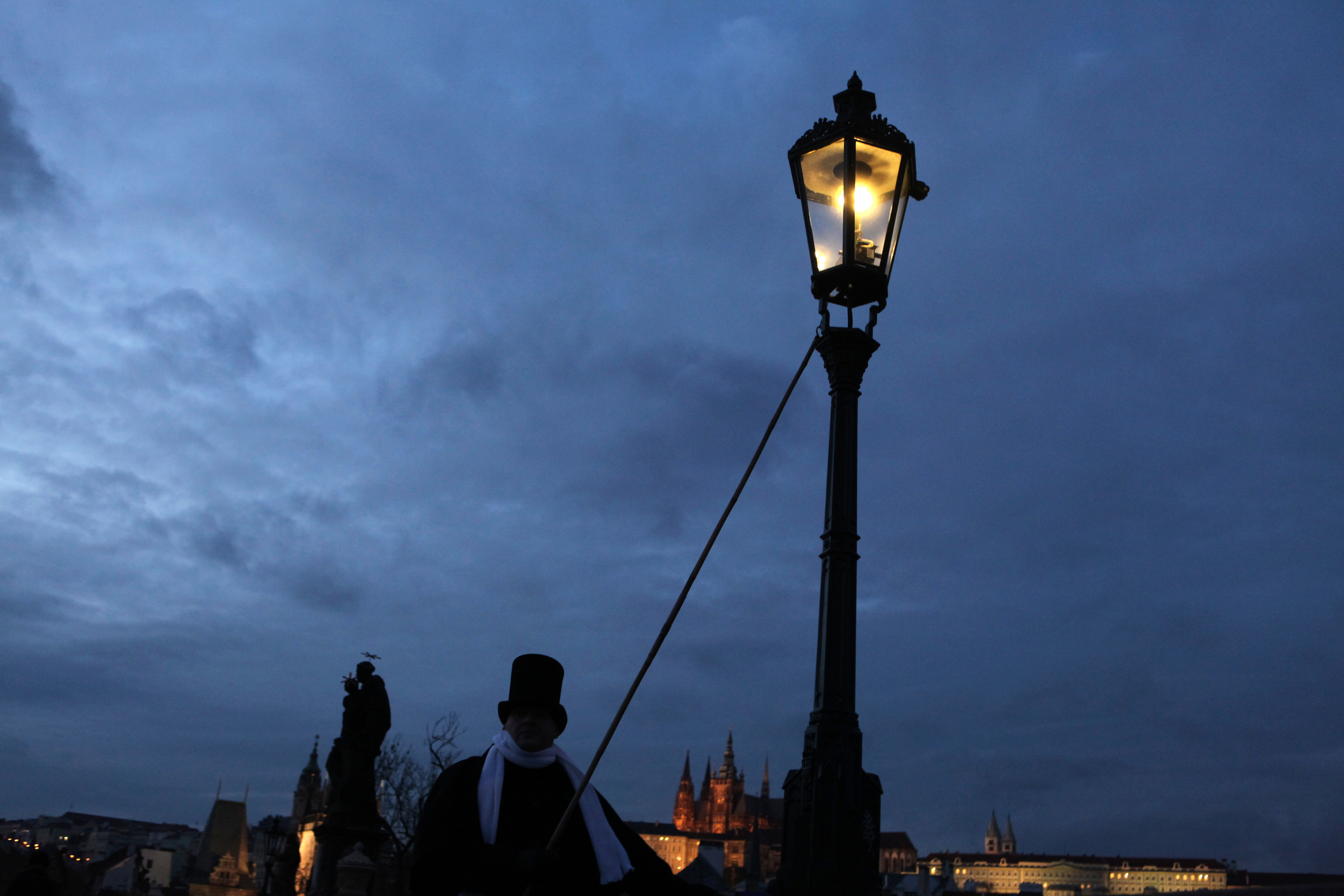 EXTERIOR
EXTERIOR
Gas Lighting and Street Lights
While whale-oil, camphene and later kerosene lamps provided lighting for domestic use, a brighter light source was needed for commercial applications. In 1790 William Murdock, a Scottish engineer, began experimenting with flammable coal gases. The result worked fine for lighting outdoor areas, such as urban streets, though its adoption for domestic uses was much slower.
In 1807 London got its first gaslit street, with the gas transported to the lamps via pipelines. The world’s first public gas works began operation in Westminster in 1813. Baltimore followed suit in 1816, and Paris in 1820. By 1826 most British towns had their own gasworks, used primarily for streetlights, public buildings, and a few private residences. By the middle of the nineteenth century there were thirteen gas companies in London and nearly one thousand in Great Britain as a whole.
Although gas was readily available, it was a new light source and distrusted for the first 50 years or so of its existence. As a consequence, it was not often used in homes until the latter part of the century. It was not until gas lighting was installed in the new Houses of Parliament in 1859 that gas lighting for interiors began to come into its own.
IMAGE:© Wrangel | Dreamstime.com – Lamplighter Lights A Street Gas Light At The Charles Bridge In P Photo
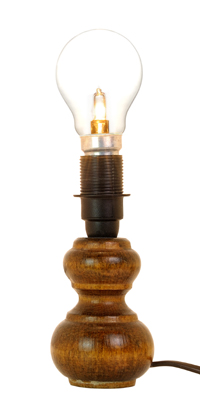 Electric Lighting
Electric Lighting
Edison did not invent the first light bulb, only the first commercially viable one. He was backed by several well-known financiers, including J. P. Morgan and the members of the Vanderbilt family, and in 1878, Edison formed the Edison Electric Light Company in New York City to pursue the venture.
A year later, in October 1879, he performed the first successful test of his new lightbulb and filed a patent on it a week later. He gave the first public demonstration on New Year’s Eve of that year. A number of other inventors had been working on the same or similar concepts, and patent litigation continued for years until finally resolved in Edison’s favor in 1889.
In the interim, Edison went on to establish a utility company to distribute electricity for his new invention. The Edison Illuminating Company went into operation in 1882 in New York City. Almost immediately, however, a battle was joined between Edison, who favored using direct current (DC), and competitors including Westinghouse, who wanted to use alternating current (AC). The latter could transmit electricity over longer distances using thinner and cheaper wires, while DC was confined to shorter distances such as those found in large urban areas.
By the end of 1887 Edison was starting to lose customers to the competing systems. The battles continued until 1892, when Edison was forced out of his own company. Financier J.P. Morgan then went on to combine Edison’s former company with an AC competitor, the Thomson-Houston Company, forming what is now General Electric. The company went on to compete successfully with Westinghouse, bringing electricity into the mainstream.
FURTHER READING AND OTHER REFERENCES
National Candle Association, http://candles.org/history/
Smithsonian; The National Museum of American History; Mining Lights and Hats, http://americanhistory.si.edu/collections/object-groups/mining-lights-and-hats
Cornish Mining World Heritage, https://www.cornish-mining.org.uk/delving-deeper/lighting
(Posted July 2016)
